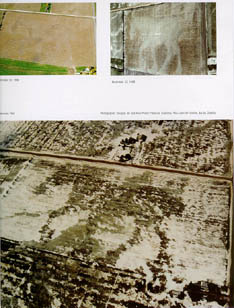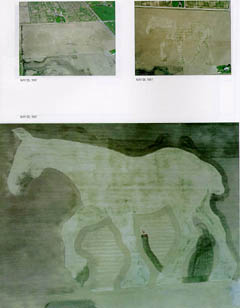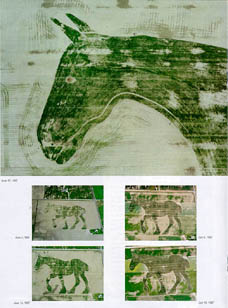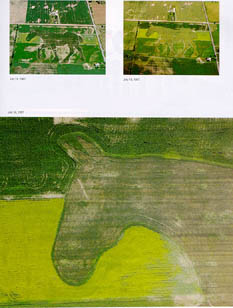

![]()
BORDER CROSSINGS August 1997/Volume 16 Number 3 Horse Against the Grain The Fafard Field Project By Meeka Walsh "A draft horse of wheat with a background of corn, canola, soybeans and alfalfa." There it is, simple as that - a description of the project underway by the MacLaren Art Centre this summer in Barrie, Ontario in conjunction with the 1997 International Plowing Match. The primary players: the MacLaren's director William Moore, Saskatchewan artist Joe Fafard and a local farmer Roy Hickling acting as curator and project co-ordinator. Those weren't the only ones of course; there was the International Plowing Match Committee, the engineering students from Georgian College who surveyed the image on the field, the farmers who did the actual field work, the people from the Canadian Foodgrains Bank who will ultimately receive and distribute the harvest and then pilots and photographers and others working in countless areas over the span of this project which began even before Joe Fafard laid hand to paper in August 1996, and will conclude in September 1997 with the International Plowing Match. There's another player too. He's the horse Joe Fafard called into being, willed into space, conjured from heart and mind and earth and seed, no less poignant an image than Michaelangelo's finger to finger painted on the ceiling of the Sistine Chapel in Rome. Who's to say, after all, where spirit resides? Look at the image first put down on the field, 1,100 by 1,900 feet - the work measured in the dimensions of painting and not agriculture. The horse, 1,400 feet long, nose to tail, possibly the largest drawing ever done. It's an image so delicate, so barely there that it had to have been inscribed by an exhalation of breath. This is the fall of 1996 and no growth is apparent. The second photograph shifts planes entirely. No longer laid down on a field, it must be a wall painting from the tomb of an Assyrian king. Then the snow falls and the image is a pentimento, the erasure of white incomplete, the shadow reading through the white covering. In the spring the growth begins, tentative and green. Tillage equipment gives the horse's frame the support he needs; a tiny red machine picks its course around the horse's feet, no bigger than a fly buzzing his belly. The green is filling in and now the horse is a fresco from the 14th century, and Giotto comes to mind. The horse's eye is incised and his ears prick forward with willingness and interest. The tiller's lines in the earth are gestural and I'm reminded once again of Fafard's unerring sense of scale. His familiarity with this subject and the honour he shows it are particularly evident in his attention to the muzzle - line of the soft closed lips, a profound quiet only a horse owns - and in the lift and delicacy of the nostril. As the vegetation becomes more dense the horse darkens, his coat suggesting a handsome bay and tricks of wind and aerial photography have him striding out a little, stretching his neck, warming, finding his way to the ground. Now the canola is in flower and it shows first as an erratic crayon line filling in colour around his muzzle. Horse is a spectacle, an astonishing visual gift apprehended by chance by travellers on a lucky flight path or by intent for those lifted in a hot air balloon on site or wound into the air on the Ferris wheel set up for the Project within range of the field. In the way that only animals do, the horse retains his equanimity, well-placed, beautifully conceived, thorough and consistent in his being. I look at these photographs and I remember an early body of work by Manitoba artist Don Reichert who took his own aerial photographs and with them made art. I think of the starkly graphic black and white photographs by Mario Giacomelli, of a terrain not ours - smaller and hilly and worked and reworked, generations of farmers' inscriptions on the Italian landscape and I think of Jim Dine's work on the walls of the Kunstverein Ludwigsburg in Germany, nine ceiling-high charcoal drawings done with the commitment and intensity with which he makes all his work, knowing that when the exhibition period ended six weeks later, rollers of white paint would obliterate his drawings and only memory and photographic documentation would remain - a pentimento more exacting, profound and elusive than even he usually seeks. So it will be with the Fafard Field Project. When the growing season has passed Fafard will travel to Barrie, Ontario to the field where his horse has grown and now waits, green and patient. And Fafard, whose initial conception of the work, whose first drawing had to plan for and anticipate its organic conclusion, will draw the last line. With a tiller he'll incise the horse's harness which will show black against the green and yellow. The planting will be harvested and the project concluded. For now, the horse remains serene, his mantle the vegetation which covers him, lustrous as a silk prayer rug. |




Border Crossings, 500-70 Arthur Street, Winnipeg, MN R3B 1G7
(204) 942-5778 or bordercr@escape.ca